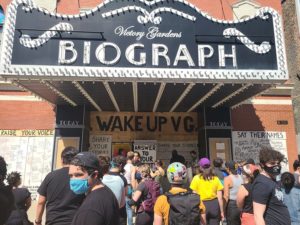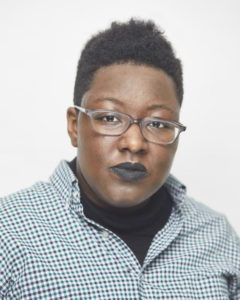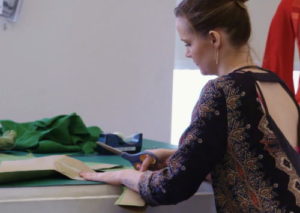In the span of two weeks in late May and April, Chicago theatre’s mythologized Steppenwolf Theatre Company seemed to be a site of contestation in the battle against inequity and for change in the American theatre. In late April, video content producer and busy Chicago freelancer Lowell Thomas II, resigned from Steppenwolf with an Instagram essay, citing personal experiences and calling for divestment due to the company’s burying of “claims of harassment, racism, and sexism to avoid accountability and real change.” A week later, artistic director Anna D. Shapiro, whom Thomas had called out by name in his resignation, announced her plans to step down from the company at the end of her contract in August 2021.
The timing may have been coincidental, but in a moment ripe for change, change had come. In a Medium response to Lowell, playwright Isaac Gómez spoke out with both/and sentiments, preaching about both the love and anger that undergirds his experiences surviving the theatre industry. What Gómez pointed to, in naming a range of predominantly white theatre institutions, is that this discussion of harm and grievances transcends Steppenwolf Theatre. Wrote Gómez, “I could say a lot about each of these institutions, but I won’t. For the context of this prayer, all you need to know is that each of these companies took a piece of my spirit that I’ve been trying to get back.”
Though Thomas’s allegations did not go into detail, a critical analysis of Steppenwolf’s four-plus-decade history of producing and hiring showcases a legacy steeped in whiteness, and a company which only in the last decade has begun to uplift artists of historically disinvested identities (largely under Shapiro’s leadership, it should be said). While Steppenwolf is often seen as the Chicago blueprint for ensemble-based storefront theatre, by which any group of friends can assemble to build a theatre company from the ground up, what goes largely uninvestigated is the sheer amount of exploitation and codified racism that shapes Chicago companies like Steppenwolf.
Around the time of Thomas’s resignation, Steppenwolf also made its season announcement, titled “The Comeback.” Again, it was coincidental in its timing but the message seemed clear: The theatre was committed to business as usual rather than to supposed actions of solidarity. And it appears to signal a lack of genuine change in the working conditions of artists, despite a year-plus of reckoning with the pandemic and calls for an anti-racist theatre industry via We See You, White American Theater (admittedly, a movement with its own issues).

Just last summer, Chicago witnessed a change in leadership that rocked the regional theatre landscape, as artistic director and executive director positions were to be collapsed into a single role at Victory Gardens Theater. As one of the few multi-million-dollar-budget companies in Chicago helmed by a person of color, Victory Gardens had emerged as a contemporary hub for diverse storytelling. Even so, it also was home to great pain and strife for staff and independent contractors, even before changes in leadership uncovered an underbelly of exploitation and harm. Workers have recounted surviving a hostile office environment with limited space, laboring on EDI initiatives that were dismissed as unfeasible, and inappropriate leveraging of artists’ relationships with their home communities.
During the protests ignited by the murder of George Floyd last May and June, Victory Gardens was boarded up with pieces of plywood, which artists then collaged with street dramaturgy murals and prompts like, “Black Lives Matter, but do they matter to this theatre?” In protest of Erica Daniels’s promotion to a new executive artistic director position, the playwright ensemble quit (for the second time in the company’s history) via open letter. Shortly following, Daniels and Steve Miller, former board president, stepped down.
“It feels like anybody who comes with ethics and morals, it just gets squashed. You think you can fix the system from within, and you just fucking can’t.”
After this tale of an internal hire gone sour, an official nationwide search for the next artistic director commenced in fall 2020, and this past April Ken-Matt Martin was selected for the position. Roxanna Conner, Victory Gardens’ director of education, became new acting managing director, and Charles E. Harris II ascended as the new board president. This all-Black leadership marks many firsts in Victory Gardens’ history, but it does not automatically redeem an institution and absolve it of its own harsh legacy. These are the stories that live in the bodies of artist workers, and Martin has taken a heartening step toward hearing them with a listening tour (currently totaling almost 100, with a goal of 200 by July’s end).
The stories of backlash at Steppenwolf and Victory Gardens hit similar beats. But what’s missing is a shared analysis of what materially needs to happen in order for a theatre “comeback” to be safe and equitable at theatres of all sizes and budgets. Public commitments to equity, diversity, and inclusion ring hollow when many artists live on poverty wages for ridiculous hours and limited means of advocating for themselves when a process goes wrong. When harm is done, when a culture refuses to shift despite changes in leadership and apparent grievances, despite a faux-pause that has reminded artists of their power and value—what must emerge for the sustainability of a theatre field that is just and nourishing?
In interviewing over a dozen theatre artists working at the intersection of institutions and independent contracting, it is clear that artists know what they need to do their work. They have been loud. They have been specific. Houses that are a part of unions like Actor’s Equity Association provide a sort of blueprint for smaller storefronts centering safety and fair wages, but most non-union houses fall short, with advocacy falling on artists’ shoulders. Artist-led initiatives in Chicago like Not In Our House, the Chicago Inclusion Project, and On Our Team have emerged to fill knowledge gaps on the working conditions of artists and to present community standards that could offer bare minimum commitments toward fostering spaces and processes that are thriveable. Another reigning sentiment among those we spoke to: that the theatre industry is losing people, both emerging artists and veterans. This trajectory will not shift unless our institutions do.

Many theatre artists come barreling out of academic institutions seeking work within artistic institutions, excited to put down roots in an artistic home where it seems the most financially stable. Said playwright and arts administrator Elon Sloan (they/them), “I thought that if I could work up to getting some sort of arts admin job that I would feel a bit more anchored in my arts practice.” Mythologies take further root, as recent graduates-turned-fellows are expecting their labor to be an educational experience rather than an exploitative one. Of Sloan’s fellowship with a well-known large company, they said, “It is just this environment where you’re temporary—you and everybody else on the same level as you is temporary, and you’re at the bottom of the rung.”
When Sloan was fired along with their fellowship peers (and thousands of arts workers across the country) in the wake of the pandemic, it felt “dizzying,” they said, to hear their institution’s leadership simultaneously spout their admiration for their labor while affirming their “ability to bounce back and be the future.” Sloan felt pressured “into holding the institution’s best interests at heart,” even as they knew their institution had “no long-term commitment to [their] career or personal well-being.” What Sloan’s experience maps is a culture of disposability for artists who work as the foot soldiers of institutions.

Olivia Lilley (she/her), artistic director of Prop Thtr, moved to Chicago in the 2000s and made waves through the city’s non-Equity DIY theatre scene, where juggling day jobs with art were the norm. In undergrad, she said she was taught and embraced that the trade-off of producing her own work was “that we can do art or things that matter to us that are not all about the bottom line.” Even so, this divorce from the bottom line can perpetuate the starving-artist narrative—what Lilley called “the paying our dues, the legendary status of what people did to make things happen.” In reality, she said, “I was just really malnourished, and probably a little exhausted and sleep-deprived. I was doing my best to treat everyone great, but I’m sure I didn’t at all times.”
Aaryanna Gariss (they/them) subsidized their freelance stage management theatre career in non-Equity theatres by working in temp agencies. They recounted many a time where “stealing the paper from somewhere else” for script printing allowed them the space to “have a little bit of time to eat a lunch.” In order to keep up with their stage management responsibilities, they dedicated an hour before their 9-to-5 job to theatre work. Gariss also often had to negotiate leaving early for rehearsals. Once finishing rehearsal, they shared, “It’s not unreasonable to expect that you would be working for a good 90 minutes.” Even after leaving the theatre, they were not off the clock; there were still daily calls to be sent and rehearsal reports to be written. In this year of our industry’s shutdown, more artists are recognizing the importance of time to wind down and/or spend time with their household.

A hustle like this is unsustainable. And even when Gariss landed a full-time development job at the Goodman Theatre, they said, “I just couldn’t do it. I was exhausted. I was miserable. I was so ethically conflicted.” The perceived urgency of the work left little time to genuinely interrogate microaggressions that persisted throughout the company. Gariss and others recalled a moment in rehearsal of a majority Black team wherein the artistic director emulated a whipping sound in a gesture of “getting back to work.” Egregious moments like this led to the Goodman to undertake internal EDI initiatives, but even in that training, third-party consultants were ill-equipped, as they did not have competencies around gender inclusivity. As a non-binary artist worker, Gariss said they felt unseen, and in allying for themself and other unheard colleagues, they said, “It feels like anybody who comes with ethics and morals, it just gets squashed. You think you can fix the system from within, and you just fucking can’t.”

In a time when companies have felt pressured to release solidarity statements, their failure to demonstrate or exercise cultural competence signals that they aren’t living up to their supposed values. In an effort to fill knowledge gaps and increase sensitivity within PWI institutions working with BIPOC artists, some companies employ cultural consultants. Even so, in rehearsal processes where actor and organizer Gloria Imseih Petrelli (she/her) has worked as a cultural consultant, she felt her “presence was a checkmark on a list, as opposed to an asset in the room.”
It is clear that a contingent position like this can only do so much good, when what needs to happen is for the leadership team and the board to invest in long-term cultural support throughout the organization. Such an infrastructure becomes especially important when theatres are called to take a stance against injustice. Noted Imseih Petrelli, “As a Palestinian, I feel immensely isolated and completely erased in our theatre communities.” She connected this to the trend of theatre companies committing to anti-racism but not extending “that grace, as it were, to the Palestinian people.” For companies that are still learning how to welcome and resource historically disinvested artists, mistakes will be made, and Imseih Petrelli contends that accountability needs to be “redemption-based” and applied “to every part of our lives.” For Imseih Petrelli, silence perpetuates inequity—but it should not be contractors’ job to both demand and then facilitate accountability processes.

When segueing from freelance to institutional roles, director Tara Branham (she/her) uses an approach that views progress as a spectrum. She said she wonders, “What is the capacity of this person in front of me? And the capacity of this company? And what are the tiny changes I can help them start to make and maybe like, hopefully, get them moving on a path?” Even so, Branham said she wishes she’d had a mentor who told her, “If you want to work with these institutions, you have to play with these institutions.” In clarifying, she adds, “I see ‘playing’ with them as offering an appropriate level of critique to be popular, edgy, but not necessarily seeking out accountability from the institution.”

The issues that theatre artists contend with aren’t unique to theatre; they are structural problems for every worker in this country. But to playwright and producer BeeBee Cooper (they/she), “The key difference with theatres is how much the phrases ‘no one is doing this for the money’ and ‘the show must go on’ join forces to verbally affirm, behind smoke and mirrors, that our art is just as corrupted by capitalism and colonial mentality as everything else.” Only in this recognition can theatres begin to dismantle practices that harm artists and alienate their communities.
Multi-hyphenate artist Aimy Tien (she/they) asserted that “producers and theatre companies need to ask themselves, ethically, if and how they should be making this show.” As a producer within storefront and film spaces, Tien acknowledges that each process is sprawling and the needs of every team vary. Still, they said they encourage their team to be vocal “if something makes them uncomfortable [or] feel unsafe, if they just need something addressed,” because the artists “matter to me more than the show.”

In order for grievances to be aired, artists must not fear repercussions. Even in companies that do have a Human Resources department, Tien noted, it is typically “about often protecting the company and not protecting the employee.” In union rehearsal processes under Actors’ Equity Association rules, a deputy is usually voted upon to act as a liaison between the union and the its members in the show regarding all working conditions. So when violations or harm happens on a show, this volunteer role positions an actor as the one responsible for reporting concerns and dangerous conditions to the union. That set-up can lead to difficulties, as artistic director Lilley put it: “It weirdly implies that [one actor is] gonna take on a bunch of emotional labor that they didn’t necessarily sign up for.” That’s one reason why the non-union Prop Thtr has built a “ladder of accountability,” with two actors as “advocates” given access to leadership and an outside mediator at a sister theatre company. Such a failsafe is in place until Prop can build the budget line to formally hire a consultant who understands the dynamics of a theatre process and can advocate for the needs of artists.

Non-union spaces can be especially dangerous. Tien recalled being a part of a production in which she ended up with splinters in her face, as her concerns about safety and a lack of mandated breaks went unheard. Actor Danyelle Monson (she/her) accepted she’s “had to be okay with the fact that I may be seen as the bad guy or the villain for speaking up for all of our rights.” Both actors have been labeled “difficult to work with,” they said, for advocating for safety, even with templates from Not in Our House serving as the foundation of community standards.
What emerged again and again in our conversations was the desire for a living wage and more humane working conditions at theatres of all sizes and budgets. Costume designer and technician Anna Wooden (she/her) turns to the film and TV industry when noting feasibility. “It’s hourly [pay], and once you tip over a certain number of hours a day, then you go into double time,” she said. “And they reimburse all your mileage. While you’re there, there’s free food.” The discrepancy is especially difficult to ignore at theatres who’ve remained committed to capital campaigns rather than supporting their administrative staff through a pandemic.

According to arts administrator Kenya Ann Hall (she/her), “History can be such a huge obstacle,” especially when institutions are built and sustained through legacy. “When you’ve been doing something one way for so long, it’s hard to figure out how to do it a different way, and how to trust how to do it that different way.” Artists consistently showcase their value to their artistic homes, but there is a huge gap in the resources and care necessary for these artists to do their work safely. As new artistic staff and freelancers make their way through these institutions, we must listen to those who have come before. So much knowledge has been lost and calls for progress disrupted, due to the itinerant nature of theatre jobs that become untenable, or have been cut short during the pandemic.
Even in the wake of season announcements, there is still time for theatre leadership to examine and address the working conditions of those they employ. In such a time of unfathomable loss, artists must recognize their power and continue to speak out against the industry “norms” that have held them back. Ultimately, it is up to leadership to hear these calls and commit to practices that finally equip artists and staff to do their best work in environments that resist exploitation in the face of urgency and supposed scarcity.
An earlier version of this story incorrectly stated that Equity deputies mediate between actors and management.
Yasmin Zacaria Mikhaiel (she/they) is a Chicago-based arts journalist, dramaturg, and oral historian. Learn more at yasminzacaria.com and follow them on Twitter @yasminzacaria. Tanuja Devi Jagernauth (she/her/hers) is a writer, theatremaker, and dramaturg.


